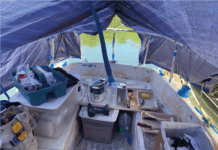With many of our readers wrapping up their spring pre-launch projects, I thought it would be a good time to offer a brief update on the progress—such as it is—on the 1971 Yankee 30 I bought just over a year ago.
The bulk of the restoration to this mighty S&S design has focused on the paint, which was about as bad as it gets on a fiberglass boat. The topside (Interlux Brightside) and deck (Interdeck) had been painted in 2014, and the Florida sun had done its damage.
The cracking and peeling was so widespread that it was clear the coating was shot. Paint on the smooth spillways was lifting so easily that I could pry it up with my thumbnail. Some sections of non-skid had worn through to reveal bare fiberglass. Ninety percent of the paint was cracked and chalky.
The failure was sad because as I dug into the project, it was clear someone had put a lot of effort into the paint job. All of the original crazed gelcoat had been sanded and sealed. The molded non-skid had been ground smooth. The deck had been faired and primed with epoxy before the glossy topcoats. Had the previous owner
simply sanded and painted the hull a few years ago, the boat would still be looking sharp.
My initial thought was an aggressive sanding followed by high-build epoxy primer would be enough to provide a clean surface for new paint to bond. However, after a few failed adhesion tests and chats with coatings experts at Total Boat, Kop-Coat (Pettit), and Akzo-Nobel (Interlux and U.S. Paint, maker of Awlgrip), it became clear that for the best results I would need to remove failing paint.
I spent two weeks testing paint removers on the topsides and sanding some sections, but having plans for a summer family trip, I entrusted the pros at Salt Creek Marina to finish the project. Six weeks later, the hull—from the keel to toerail—looked like new. The media-blasted bottom had Trinidad bottom paint over a Pettit Protect epoxy barrier coat. The topsides shined with three coats of AwlCraft, Salt Creek’s spray coating of choice.
After swallowing the $8K bill for the hull overhaul (a fair exchange for a road trip with teenage sons), I decided I’d
attack the deck. The lessons came fast and furious. Five months after starting, and with close to 200 hours into the project (much of it consumed by testing), I’m finally pulling off the masking tape.
For the shiny sections, I roll-and-tipped Awlgrip—Oyster White to match the hull. The paint is hard and durable, and I don’t want to repeat this project for a while. After two coats, Opal looks great, but I plan to add at least one more top coat, and still have to lay down the Awlgrip/GripTex non-skid and add the cove stripe.
Since the non-skid primer is sanded for the final coats, it isn’t too slippery for day sailing. So I think I’ll do some of that instead of more painting. As rewarding as this work has been, its most important lesson has sunk in. Time is precious, and there are few better ways to spend it than with the people we love—even better if it’s time on the water.





































